Abstract
Reconfigurable intelligent surfaces (RIS) have emerged as a promising enabler for beyond-5G and 6G networks, offering controllable propagation environments to enhance coverage and spectral efficiency. This study investigates and compares multiple RIS configuration strategies, including analytical baselines such as the phase gradient reflector (PGR) and focusing lens (FL), optimization-driven approaches via gradient-based optimization (GBO), and learning-assisted designs through hybrid Mixture-of-Experts (MoE) and CNN-based gating. A unified simulation framework was developed to evaluate amplitude and phase profiles, expert-selection heatmaps, and coverage improvement maps, alongside a detailed analysis of the average path gain evolution over iterations. Quantitative results show that PGR and FL achieve average path gains of −112 dB and −97 dB, respectively, while GBO attains the highest gain of approximately −92 dB. The Hybrid MoE achieves −93.5 dB with localized coverage enhancements exceeding 40 dB, whereas CNN-gating maintains smoother and more generalized coverage improvements up to 20 dB. Results demonstrate that while PGR and FL provide predictable yet limited performance, GBO yields the highest path gain at the cost of computational complexity. MoE balances interpretability and adaptability through smoother expert-weight distributions, whereas CNN-gating enforces sharper, binary-like spatial decisions, enhancing coverage in challenging blind spots. The comparative findings highlight a performance spectrum ranging from interpretable analytical models to highly adaptive learning-based schemes, revealing trade-offs between flexibility, computational cost, and generalization capability, while also underlining RIS’s potential for sustainable and energy-efficient networking. These insights position hybrid and learning-driven RIS designs as promising candidates for scalable, adaptive deployment in future wireless systems.
1. Introduction
Wireless communication technologies have undergone a profound transformation over the past decade. With 5G, key objectives such as high data rates, low latency, and wide coverage have been largely achieved; however, challenges such as increasing device density, the need for higher frequency bands, and energy efficiency have become decisive in shaping the 6G vision. In particular, coverage issues in dense urban areas, high propagation losses at mmWave and terahertz frequency bands, and the growing demand for sustainable networks necessitate innovative solutions beyond conventional approaches.
In this context, Reconfigurable Intelligent Surface (RIS) technology has recently emerged as a revolutionary approach. RIS reshapes the propagation environment by software-defined adjustment of the amplitude and phase of electromagnetic waves through a large number of low-cost passive elements on its surface []. Therefore, RIS transforms the wireless channel itself into an optimization variable, without requiring any additional hardware at either the transmitter or the receiver. Compared to conventional multi-antenna systems, this provides significant advantages in terms of lower energy consumption, cost-effectiveness, and flexible deployment. In line with prior works, a variety of RIS architectures and applications have been studied extensively, as summarized below.
The significance of RIS technology extends beyond improvements in coverage and data rate. It plays a critical role in building energy-efficient communication networks, supporting low-latency mission-critical applications, and realizing the smart environment vision envisioned by 6G. Due to its inherently simple hardware requirements, RIS can be widely deployed in large-scale networks and seamlessly integrated with existing infrastructures. Therefore, RIS is considered a fundamental component for the future of sustainable, reliable, and scalable wireless communication networks.
The motivation behind this work stems from the need to move beyond conventional analytical RIS designs, such as the focusing lens and phase gradient reflector, which, despite their interpretability, offer limited adaptability in realistic multi-user and dynamic environments. While gradient-based optimization methods provide stronger performance, their high computational cost and lack of scalability hinder practical deployment. To address this gap, two advanced approaches—MoE and CNN-based gating—that combine the interpretability of expert priors with the adaptability of learning-driven optimization are introduced and evaluated comparatively. The originality of this study lies in presenting, within a unified framework, the first comprehensive side-by-side analysis of analytical, optimization-based, and learning-enhanced RIS strategies, incorporating amplitude and phase profile evaluation, expert-selection heatmaps, coverage maps, and path gain distributions. By systematically benchmarking these methods, the work not only validates the strengths and limitations of existing approaches but also establishes hybrid and CNN-based gating as promising directions for scalable, adaptive RIS deployment in 6G networks.
The remainder of this article is organized as follows: Section 2 presents an overview of the related works on analytical, optimization-based, and learning-driven RIS configurations, providing the background for the proposed comparative analysis. Section 3 details the simulation environment, the modeling of the reconfigurable intelligent surface, and the implementation of various configuration strategies, including the Focusing Lens, Phase Gradient Reflector, Gradient-Based Optimization, Hybrid Mixture-of-Experts, and CNN-based gating. Section 4 presents a comprehensive performance evaluation in terms of amplitude and phase profiles, coverage improvement maps, expert-selection heatmaps, and average path gain analysis. Section 5 critically examines the strengths and limitations of analytical, optimization-based, and learning-driven approaches, highlighting the trade-offs in scalability, interpretability, and computational complexity. Finally, Section 6 summarizes the main findings and outlines implications for the sustainable and adaptive deployment of RIS technologies in future 6G networks.
The novelty of this study lies in the unified and physically consistent comparison of analytical, optimization-based, and learning-enhanced RIS configuration strategies within the same digital twin environment. Unlike previous studies that focus on individual methods or simplified setups, this work jointly evaluates the Focusing Lens, Phase Gradient Reflector, Gradient-Based Optimization, Hybrid Mixture-of-Experts, and CNN-based gating schemes using a single Sionna RT–based ray-tracing framework. Moreover, by incorporating both amplitude–phase co-optimization and data-driven gating, the proposed approach bridges the gap between interpretable analytical models and adaptive machine-learning-based designs. This integrated analysis, to the best of our knowledge, represents the first comprehensive benchmarking of hybrid and AI-assisted RIS control strategies, establishing a foundation for scalable and sustainable deployment in future 6G networks.
2. Related Works
Recent studies have demonstrated that RIS can be utilized not only in classical cellular communications but also across a wide range of domains. These include electromagnetic modeling and physically consistent surface design, active and hybrid architectures, multi-RIS resource allocation, integration with movable antennas, channel estimation, integrated sensing and communication, positioning, experimental prototypes, and energy efficiency. Below, the literature is reviewed in detail, covering these topics and highlighting diverse perspectives.
Reconfigurable Intelligent Surfaces have emerged as one of the cornerstones of the vision of software-defined wireless environments. With their low cost, low power consumption, and flexible deployment capabilities, RISs are strong candidates for 6G systems. The literature extensively examines the opportunities provided by RIS in the context of smart radio environments, with comprehensive surveys covering a broad spectrum ranging from electromagnetic transformations to capacity enhancement and modulation techniques []. Moreover, it has been analytically demonstrated that RIS can achieve performance close to the ideal even under practical constraints such as passive beamforming, modulation, and resource allocation [].
Electromagnetic-level modeling of RIS has also been at the center of research. Ray-based models that explain scattering processes through geometric optics principles have been shown to accurately represent anomalous reflection and diffraction effects while considering power conservation at the macroscopic scale [,]. Similarly, physically consistent approaches based on the optimization of reradiation modes, made practical by adapting the resulting amplitudes to surface impedances, have been validated through both full-wave simulations and experimental prototypes [].
Beyond the basic architecture, flexible intelligent metasurfaces employing element movement combined with passive phase shifters allow channels to be reshaped in both position and phase, enabling significant performance improvements in multipath environments []. Active RIS architectures, on the other hand, stand out with their signal amplification capability compared to passive structures. In dual-active RIS scenarios, studies that account for inter-excitation effects have proposed solutions using feedback-based signal models and penalty-based decomposition methods to enhance the overall rate []. Furthermore, a novel RIS framework, capable of simultaneous transmission and reflection, has enabled the development of solutions adapted to the diversified QoS requirements of different user groups, achieving improved overall performance through block coordinate descent strategies []. This technology has also demonstrated potential in interference-limited NOMA networks, where closed-form performance metrics highlight its ability to suppress interference and extend coverage [].
Multi-RIS architecture has recently become another prominent research direction. Studies investigating end-to-end channel statistics under independent but non-identical channels have compared full-RIS-assisted and opportunistic-RIS-assisted schemes, revealing scenario-dependent advantages in terms of ergodic capacity and energy efficiency []. In such scenarios, RIS-user association has been shown to be critical, with joint optimization of association matrices and active-passive beamforming reported to increase the overall rate []. Likewise, in panel-based large intelligent surface concepts, scalable and cost-effective solutions have been developed by employing genetic algorithms to overcome the high complexity of mixed-integer linear programming-based approaches [].
Beamforming and rate optimization in RIS-assisted single-cell scenarios have also been widely studied. For multi-antenna access points, the joint optimization of passive phase shifters and active beamforming has enabled power consumption minimization while satisfying user SINR constraints []. Similarly, frameworks developed for maximizing data rates in 6G systems have reformulated the nonlinear problem into a power minimization problem, which was then effectively solved using alternating optimization techniques [].
The integration of RIS with Movable Antennas (MA) has attracted attention for introducing spatial degrees of freedom into the system. Theoretical analyses indicate that MAs provide significant SNR and sum-rate gains, especially under near-field conditions and multi-antenna configurations, while the benefits remain limited in far-field or single-antenna scenarios []. To this end, fractional programming-based algorithms have been developed to maximize sum rate, achieving notable superiority compared to fixed antennas []. Additionally, studies examining the impact of geometry and the number of effective elements on performance have shown that MA-RIS can achieve lower outage probability and extra SNR gain with fewer antennas []. Optimization of such integrations, involving the sequential solution of antenna positions and passive phase configurations, has improved achievable data rates in multi-user scenarios [].
On the channel estimation front, approaches offering high accuracy with low pilot overhead have been highlighted for both dual-RIS and semi-passive RIS systems. Using a single-RF-chain active RIS, two-timescale channel properties have been reliably estimated with line-of-sight (LoS)-aided algorithms, while reducing computational complexity []. In semi-passive RIS-assisted mmWave systems, a two-stage approach has been developed: the static BS-RIS channel was estimated using super-resolution techniques, while the time-varying UE-RIS channel was estimated through a parallel factor least-squares (LS) model, achieving substantial improvements in accuracy and spectral efficiency compared to classical LS, compressed sensing, and minimum mean square error methods [].
The role of RIS in Integrated Sensing and Communication has also been extensively explored. In symbiotic radio systems, RIS-assisted beamforming designs have balanced the trade-off between communication rate and target detection accuracy, achieving rank-one solutions through successive convex approximation and semidefinite relaxation techniques []. Moreover, studies deriving Cramér-Rao lower bounds for both passive and semi-passive RIS scenarios have shown that waveform and phase optimization improve sensing sensitivity in angle and radial velocity estimation []. Similarly, by leveraging the amplitude control capability of active RIS, the separation of RIS-reflected signals in scattering environments has enabled sequential estimation of azimuth angle-of-arrival and distance, achieving sub-meter positioning accuracy [].
In parallel with these theoretical and simulation-based studies, experimental demonstrations testing the practical applicability of RIS have gained prominence. Under 3GPP 5G channel models, average bit error rate and rate analyses for RIS-assisted massive MIMO systems have quantified the decisive impacts of antenna and RIS element numbers as well as phase resolution on performance []. Additionally, a dual-coverage passive RIS prototype operating at 27 GHz was integrated into a 5G NR-compliant test platform, and indoor measurements demonstrated meaningful improvements in key performance indicators such as SINR and sum rate []. For applications requiring lower latency, edge-integrated and visually steered beam-tracking prototypes have successfully reduced RIS control delays to the millisecond level [].
Finally, RIS technology also contributes significantly in terms of energy efficiency and network intelligence. Under realistic power consumption models, RIS-assisted systems have been reported to achieve up to three times higher energy efficiency compared to traditional relays []. Integrated frameworks combining the communication performance of passive and active RIS with ambient RF energy harvesting show promise in terms of energy efficiency and sustainability metrics []. Furthermore, in heterogeneous computing power networks, RIS- and device-to-device-based task offloading scenarios have demonstrated reduced energy consumption and latency through joint optimization of phase, beamforming, and resource allocation [].
All of these technological advancements, when complemented by artificial intelligence (AI)-based approaches, can yield more effective and scalable solutions. In particular, machine learning algorithms have demonstrated superior performance over conventional methods by enabling adaptive decision-making [], efficient resource utilization, and real-time optimization []. Similarly, learning-driven schemes have enhanced channel estimation accuracy in RIS-assisted systems [] and improved energy efficiency in large-scale IoT deployments []. Such evidence highlights the potential of learning-driven frameworks to further strengthen the role of RIS in sustainable and intelligent next-generation wireless systems.
In summary, while existing studies have addressed various aspects of RIS design—from analytical modeling to AI-enhanced optimization—there remains a lack of unified benchmarking under a physically consistent digital twin environment. This gap is addressed in the present work through the integrated evaluation of analytical, optimization-based, and learning-driven configurations.
Table 1 summarizes representative RIS studies in comparison with the proposed approach, highlighting the methodological gap that this work addresses.

Table 1.
Comparison of representative RIS studies and the proposed approach.
The analysis summarized in Table 1 clearly situates the present study within the current State-of-the-Art. Compared with previous research on reconfigurable intelligent surfaces (RIS), the proposed approach establishes a unified and physically consistent benchmarking framework that integrates analytical, optimization-based, and learning-driven strategies within a single digital-twin environment. Unlike earlier works that assess individual RIS control paradigms in isolation, this study enables a joint and systematic comparison across diverse configurations using NVIDIA’s Sionna ray-tracing (RT). The results demonstrate that the hybrid Mixture-of-Experts (MoE) model with CNN-based gating achieves superior adaptability and generalization, while preserving physical interpretability and significantly reducing computational complexity. Through this integration, the proposed framework advances the design of scalable, energy-efficient, and sustainable 6G wireless communication systems.
3. Materials and Methods
In this study, the performance of reconfigurable intelligent surfaces (RIS) is investigated in a campus-like environment by employing advanced ray-tracing simulations. The analysis aims to compare conventional analytical RIS phase design methods with optimization-based and learning-based strategies. To this end, the NVIDIA Sionna v1.2.1 [,] was used as the core simulation engine, while custom Python 3.10 implementations were developed to realize RIS-specific functions, optimize phase distributions, and integrate machine learning components.
RIS is modeled as a two-dimensional array of unit cells, each separated by half-wavelength spacing, that can independently impose a phase shift on the incident electromagnetic wave. The collective configuration of these cells creates controllable reflection patterns that can focus, steer, or redistribute energy in the wireless channel. The general input–output relation of the RIS-assisted link can be expressed as:
where represents the channel from the transmitter to RIS, denotes the channel from RIS to the user, is the diagonal matrix encoding the RIS phase profile, is the transmitted signal, and corresponds to additive noise. This model provides the foundation for both analytical and data-driven RIS design strategies.
Several distinct configuration methods were implemented and compared to demonstrate the flexibility of RIS technology. These methods can be broadly categorized into baseline analytical designs, where the phase profiles are determined through closed-form rules, and optimization-driven approaches, where the amplitude and phase profiles are iteratively adapted to the wireless environment. The former category includes the focusing lens and phase gradient reflector, which serve as interpretable reference designs. The latter encompasses gradient-based optimization, hybrid mixture-of-experts, and CNN-gated configurations, which leverage numerical optimization and learning to enhance performance. By jointly considering both categories, the evaluation provides a comprehensive perspective on the trade-off between analytical tractability and adaptive efficiency in RIS-assisted communication systems.
3.1. Baseline RIS Configurations
Several distinct configuration methods were implemented and compared to demonstrate the flexibility of RIS technology. Two canonical RIS configurations are evaluated to establish meaningful benchmarks: the FL and PGR, both of which are implemented in Sionna. These two schemes represent intuitive baselines: the FL achieves constructive focusing at a fixed point, whereas the PGR enables directional beam steering. Both serve as interpretable reference methods for comparing gradient-based or learning-driven RIS optimizations.
3.1.1. Focusing Lens
In the near-field regime, RIS can be configured to behave as an electromagnetic lens that concentrates energy onto a specific target location. The focusing lens [] configures the RIS phase such that the contributions from all unit cells add up coherently at a designated focal point. For a source at position , a target at and an RIS element at the required phase compensation is given by the following:
where is the wave number. This ensures that reflected signals from all unit cells add coherently at the target.
3.1.2. Phase Gradient Reflector
In far-field applications, steering the reflection angle is more efficient than focusing. PGR configures the RIS as an ideal planar reflector with a prescribed reflection angle. RIS is thus configured with a linear phase gradient, defined as follows:
where and are the incoming and reflected unit direction vectors, respectively, and is the RIS surface normal []. The linear phase gradient configuration is selected as a canonical analytical baseline because it provides a closed-form and physically interpretable model for far-field beam steering, ensuring consistent comparison across optimization and learning-based methods. In contrast, nonlinear or distance-dependent phase profiles are better suited to near-field conditions, where the curvature of the wavefront becomes significant and user-specific focusing is required.
3.2. Optimization-Based RIS Configurations
3.2.1. Gradient-Based Optimization
While FL and PGR configurations provide intuitive and analytically tractable benchmarks, they remain hand-crafted solutions that do not adapt to the specific wireless environment or user distribution. To overcome these limitations, gradient-based optimization (GBO) is considered next, as implemented in Sionna RT.
In this framework, the RIS parameters—including the phase profile , the amplitude profile and even the power allocation across reradiation modes—are treated as trainable variables. These parameters are iteratively updated through gradient descent with the objective of maximizing the average path gain at the target receivers as expressed in Equation (4) [].
Here path gain experienced by user , and the expectation operator accounts for all served receivers. To ensure feasibility, the mode power variables are constrained to be non-negative and to sum to one.
This data-driven optimization procedure enables the RIS to automatically learn amplitude–phase configurations that exploit multipath propagation and spatial diversity, in contrast to the fixed analytical designs of FL and PGR. Consequently, GBO forms the foundation upon which more advanced schemes—such as MoE and CNN-gated optimization—are subsequently built.
3.2.2. Hybrid Mixture-of-Experts
The Hybrid Mixture-of-Experts framework provides a physics-inspired approach to phase control in RIS systems by combining far-field (FF) and near-field (NF) focusing strategies. Each RIS element can be viewed as a “local expert” that selects between two candidate phase responses: one optimized for far-field beam steering, and another tailored to near-field spherical focusing. The hybrid mode, therefore, interpolates between these two regimes through a gating mechanism.
Formally, let denote the phase profile required for far-field focusing at the RIS element located at row , column , and is expressed as follows:
where is the offset vector of the element and is the projected phase gradient determined by the difference between incident and reflected wave vectors.
For the near-field case, the phase is obtained from the sum of distances between the RIS element and the transmitter/receiver:
where denotes the wavenumber, and , represent the element’s distance to the source and destination, respectively.
A hybrid phase map can then be constructed as follows:
where is the gating weight that interpolates between the two modes. The parameter can be optimized using gradient descent, subject to quantization constraints reflecting realistic phase shifters. The optimization of the gating weights under quantization constraints employs a bounded gradient-descent procedure using the Adam optimizer. While a formal proof of global convergence is intractable due to non-convexity, empirical training curves demonstrate stable convergence within approximately 120 iterations, with the quantization steps preserving numerical stability.
This formulation provides a smooth interpolation between NF and FF profiles. The transition between these two regimes is explicitly defined according to the Fraunhofer distance (), where the Hybrid MoE jointly optimizes amplitude and phase within the near-field region () and simplifies to phase-only control beyond this threshold (). Conceptually, each RIS element acts as a local expert deciding the degree of emphasis on NF versus FF behavior. The Hybrid MoE, therefore, serves as a physics-guided yet flexible baseline configuration method and establishes the foundation for subsequent learning-based gating mechanisms.
3.2.3. Convolutional Neural Network-Based Gating
While the Hybrid Mixture of Experts (MoE) provides a physics-inspired baseline by interpolating between far-field (FF) and near-field (NF) phase responses, its performance is limited by fixed or pre-defined gating weights . To overcome this limitation, a Convolutional Neural Network (CNN)-based gating mechanism that adaptively learns spatially varying interpolation weights from data is developed.
In this formulation, the hybrid phase distribution is still constructed as a weighted combination of and (Equation (7)). The crucial distinction lies in the way the gating coefficient is determined: instead of being heuristically set, is predicted by a CNN:
where denotes the CNN with trainable parameters , and may include auxiliary features such as user locations or path geometry.
To optimize the gating network, a composite loss function that balances path gain maximization, smoothness regularization, and expert alignment is defined. Let denote the average path gain under phase configuration . The training loss is:
where denotes the path gain function, denotes the total variation regularizer enforcing smoothness across the RIS surface, and the last term penalizes excessive deviation from teacher experts .
The total variation is expressed as:
The circular phase distance metric used in the alignment term is:
This ensures wrap-around consistency in the phase domain.
Table 2 summarizes the training hyperparameters used for the CNN-based gating model. The network was trained with the Adam optimizer and a piecewise constant learning rate schedule, using an initial learning rate of . A total of 1000 iterations were performed, with a 60-iteration warm-up phase focusing only on alignment and total variation (TV) losses before including the path-gain maximization objective. The TV weight was adjusted from to after 200 iterations, while the alignment loss coefficient was fixed at 0.30. In addition, RIS amplitudes and mode-power allocations were trained jointly, with the latter normalized at each step. This configuration ensured stable convergence and balanced performance between interpretability and optimization accuracy.

Table 2.
Training hyperparameters for CNN-based gating.
The CNN architecture was chosen for its ability to model spatial correlations between adjacent RIS elements, allowing the network to learn locally consistent phase-distribution patterns. Hyperparameters listed in Table 1 were empirically optimized using grid search on a validation subset, balancing convergence speed and phase-map smoothness. The Leaky ReLU activation was adopted to prevent gradient vanishing and preserve phase continuity, which yielded the most stable convergence among tested alternatives.
Through training, the CNN effectively partitions the RIS surface into regions optimized for NF and FF service. During training, the CNN implicitly learns the Fraunhofer boundary (), assigning higher gating weights to far-field samples and lower weights to near-field ones, thereby ensuring a smooth transition across the two propagation regimes. Elements with emphasize far-field beam steering, those with prioritize near-field focusing, and intermediate values enable blended operation. This learning-driven gating mechanism thus extends the Hybrid MoE framework by replacing heuristic weights with adaptive, data-driven predictions, yielding superior robustness to user dynamics and channel variability.
3.3. Simulation Environment
The evaluation was carried out in a campus-like outdoor scenario that was carefully modeled as a digital twin of a real environment []. A three-dimensional representation of the campus was generated using Blender [] in combination with geographic data from OpenStreetMap []. This allowed the simulation to incorporate buildings, streets, and open spaces with realistic geometry. The electromagnetic material properties of walls, floors, and ground surfaces were calibrated according to the ITU-R P.2040-2 [] recommendations, ensuring that reflections, penetrations, and diffractions were modeled with high fidelity. In particular, concrete, brick, and metallic surfaces were assigned frequency-dependent dielectric constants and conductivities, enabling Sionna’s ray-tracing engine to accurately account for propagation losses.
The wireless propagation was simulated using the Sionna RT library, which provides a physically consistent ray-tracing framework fully integrated with TensorFlow. Unlike stochastic geometry-based approaches, this framework explicitly models all multipath components generated by the scene. Reflections of up to second order were considered, and both line-of-sight (LoS) and non-line-of-sight (NLoS) propagation conditions were included in the evaluation.
The system layout is illustrated in Figure 1, where the blue marker denotes the transmitter (Tx), the red marker indicates the RIS, and the green markers correspond to receiver (Rx) positions distributed across the campus. This spatial arrangement was selected to maximize the interaction between the base station, the RIS, and users located in shadowed regions. During training, user positions and orientations were randomly sampled within the campus-scale digital-twin environment, encompassing both LoS and NLoS conditions as well as near- and far-field regions. This environmental variability ensured that the CNN-gating and Hybrid MoE models learned spatially robust representations capable of generalizing unseen propagation geometries.

Figure 1.
Three-dimensional ray-tracing scenario rendered in Sionna RT. The blue marker denotes the transmitter (Tx), the red marker represents the reconfigurable intelligent surface (RIS), and the green markers indicate user receiver (Rx) positions at pedestrian height.
Within this environment, a single rooftop base station was deployed as the transmitter (Tx), equipped with an planar antenna array following the TR 38.901 specifications. The operating frequency was set to 3.5 GHz, with a total bandwidth of 20 MHz. The receivers (Rx) were modeled as single-element dipoles placed at pedestrian height, distributed across the scene to evaluate coverage in both LoS and shadowed regions.
The reconfigurable intelligent surface (RIS) was positioned strategically on a building facade to enhance coverage in otherwise weak-signal areas. The RIS had a physical size of 2 m × 2 m, discretized into sub-wavelength elements with spacing. Its placement and orientation were chosen to maximize interaction with both the base station and target users, ensuring that the reflected beams had a meaningful impact on network performance.
Simulation setup provides a controlled yet realistic testbed where RIS-enabled wireless propagation can be studied under reproducible and physically meaningful conditions. The detailed simulation parameters are summarized in Table 3.

Table 3.
Simulation setup parameters.
In order to determine whether the transmitter and users operate in the near- or far-field region of the RIS, the Fraunhofer distance [] was considered. For a square aperture of size () and carrier wavelength (), the far-field threshold is given by the following:
with a side length of approximately () and an operating frequency of (3.5 GHz), the corresponding Fraunhofer distance is (). This Fraunhofer threshold not only defines whether a receiver lies in the near- or far-field region but also determines which optimization formulation is applied in later sections (i.e., amplitude–phase co-optimization in the near-field and phase-only control in the far-field). Hence, users located closer than this threshold to the RIS are categorized as near-field, while those further away are treated as far-field. Based on their 3D coordinates within the simulated campus environment, Rx1 and Rx2 fall inside the near-field region, Rx3 lies beyond the Fraunhofer distance and is therefore in the far-field, and the transmitter is situated approximately at the transition boundary. This spatial arrangement enables the evaluation of RIS-aided communication under both near-field and far-field conditions within the same scenario.
To provide a broader methodological context, the proposed CNN–MoE framework was compared conceptually with previously reported RIS optimization methods. Earlier analytical studies, such as [,], rely on iterative amplitude–phase tuning, while fully connected neural networks in [] demonstrate limited scalability to large RIS. In contrast, the present model integrates convolutional spatial feature extraction and expert-based routing, achieving faster convergence and improved physical interpretability. These methodological differences establish the proposed framework as a hybrid bridge between analytical optimization and data-driven learning approaches.
4. Results
Several distinct configuration methods were implemented and compared to demonstrate the flexibility of RIS technology. These methods can be broadly categorized into baseline analytical designs, where the phase profiles are determined through closed-form rules, and optimization-driven approaches, where the amplitude and phase profiles are iteratively adapted to the wireless environment. The former category includes the FL and PGR, which serve as interpretable reference designs. The latter encompasses GBO, MoE, and CNN-gated configurations, which leverage numerical optimization and learning to enhance performance. By jointly considering both categories, the evaluation provides a comprehensive perspective on the trade-off between analytical tractability and adaptive efficiency in RIS-assisted communication systems.
4.1. Impact of RIS Deployment on Signal Propagation
Figure 2 and Figure 3 illustrate the signal propagation in the campus scenario with and without RIS deployment. In the absence of RIS (Figure 2), users located in shadowed regions experience only weak multipath components due to obstruction of the direct line-of-sight links. By contrast, when RIS is introduced on the building facade (Figure 3), additional strong reflected components are generated toward the users, as indicated by the thick propagation rays. These new paths significantly improve the effective channel conditions by redirecting energy into previously blocked areas.
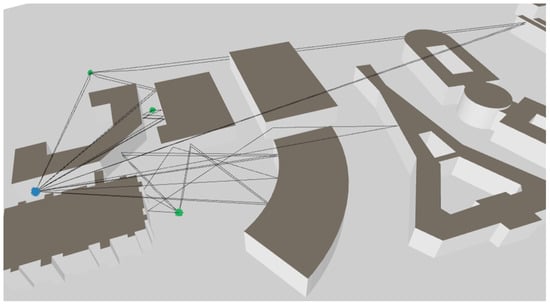
Figure 2.
Signal propagation in the campus scenario without RIS deployment. Due to the absence of controllable reflections, most users in shadowed areas are served only by weak or obstructed multipath components, resulting in limited coverage and degraded link quality. The blue marker denotes the transmitter, while the green markers represent receivers.
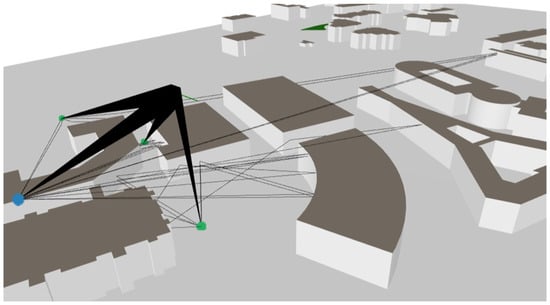
Figure 3.
Signal propagation in the campus scenario with RIS deployment. The RIS positioned on the building facade introduces additional reflected components (highlighted rays), which redirect energy into previously shadowed regions and create stronger constructive paths toward the receivers. The blue marker denotes the transmitter, while the green markers represent receivers.
This visualization provides an intuitive interpretation of the RIS effect, complementing the quantitative evaluations presented in the following subsections. Specifically, it highlights how RIS transforms the propagation environment from one with limited and weak multipath connectivity into one with enhanced link diversity and stronger constructive signal components.
4.2. Baseline RIS Configurations’ Results
4.2.1. Evaluation of Focusing Lens
Figure 4 depicts the amplitude profile of the FL configuration for three distinct user locations (modes 0–2). As expected, the amplitudes remain constant and close to unity across the entire RIS surface, confirming that the FL approach relies exclusively on phase adjustments to achieve constructive interference at the intended focal point. This uniform distribution also reflects the theoretical design of the FL in Sionna, where amplitude weights are fixed to preserve total radiated power.
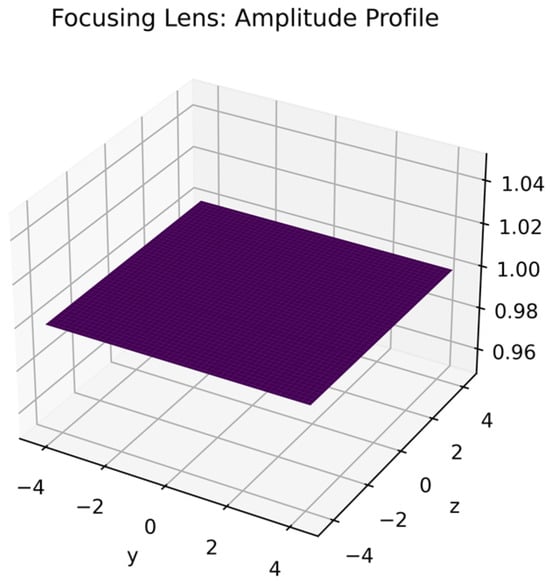
Figure 4.
Amplitude profile of the RIS elements obtained with the FL strategy. Since the resulting amplitude distribution is identical across all propagation modes, a single representative map is provided. The uniformity of the amplitude profile reflects the inherent design of the FL approach, which focuses energy without introducing mode-dependent amplitude variations.
Under the Focusing Lens setting, the phase maps in Figure 5 exhibit smooth, almost planar ramps across the RIS aperture, which is the expected signature of a geometric phase constructed from the sum of transmitter–element and element–receiver path lengths. Because the transmitter–RIS distance lies in the far field, the incident wavefront on the RIS is approximately planar; consequently, the synthesized FL phase predominantly manifests as a linear tilt whose orientation changes with the user location. The ramp is steeper for the closer Fresnel-zone receiver (mode 1), slightly gentler for mode 0, and milder for the farthest user (mode 2), consistent with the different focusing distances. Absolute phase levels in these plots are unwrapped and thus arbitrary; what governs the wavefront shaping is the local gradient (modulo ), which remains smooth and free of high-frequency fluctuations. Combined with the uniform amplitude profile reported earlier, these phase maps confirm that FL allocates equal magnitude across the aperture and performs focusing purely through a spatially coherent phase prescription, yielding a physically consistent realization of near-/intermediate-range focusing (modes 0–1) and a gradually diminishing focusing demand as the receiver approaches the far-field regime (mode 2).
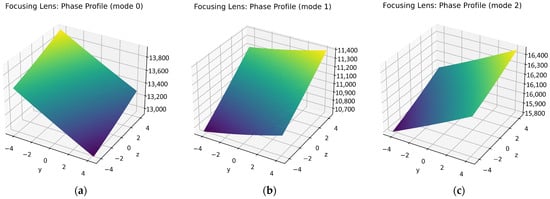
Figure 5.
Phase profiles of the RIS elements obtained with the FL strategy. The panels show the optimized phase distribution across the RIS surface for different propagation modes: (a) mode 0; (b) mode 1; (c) mode 2. The color scale represents the phase values within the interval , where brighter colors correspond to phase values close to and darker colors correspond to values near , highlighting how the method manipulates phase shifts to achieve constructive signal combination and improved coverage for user-specific channel conditions.
Overall, these results are fully consistent with the theoretical operation of FL. By enforcing uniform amplitudes and user-specific phase gradients, the RIS is effectively transformed into an electromagnetic lens that concentrates the reradiated energy toward a designated user location. This confirms the validity of the FL method as a baseline analytical configuration for RIS-assisted communication systems.
The coverage improvement map for the FL configuration (Figure 6) clearly demonstrates the localized nature of the RIS-assisted gain. The colormap indicates that most of the environment remains at a baseline level (dark regions corresponding to no improvement), while specific areas around the intended receiver positions exhibit strong enhancements, in some cases exceeding 20 dB. This pattern is a direct outcome of the FL design: since the phase profile is optimized to focus energy toward one designated target, the resulting wavefront constructively adds only along certain spatial directions while leaving most of the environment unaffected.
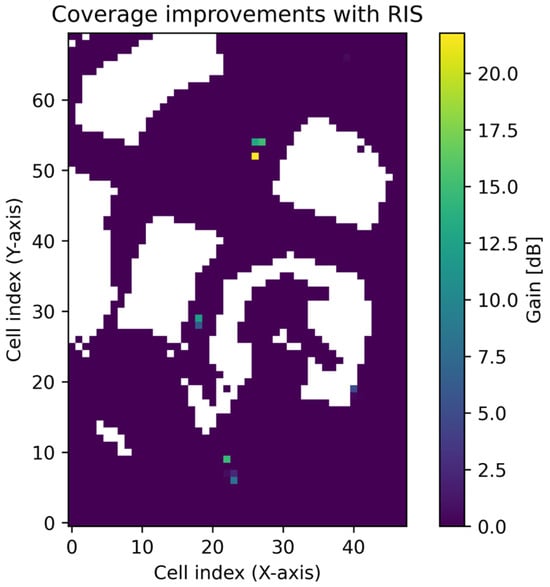
Figure 6.
Coverage improvement map under the FL configuration, showing localized signal enhancement due to RIS-assisted focusing. The high-gain regions (up to 20 dB) appear only in limited spatial areas, reflecting the single-user centric nature of the method.
The gain distribution also aligns well with the earlier near-/far-field analysis. For receivers located in the Fresnel zone (modes 0 and 1), the focusing effect produces concentrated “hot spots,” visible as narrow, high-gain regions in the map. In contrast, for the more distant user (mode 2), the focusing translates into a less sharply defined improvement zone, consistent with the gradual transition to the far-field regime. The sparse and localized nature of these improvements highlights both the strength and limitation of FL: it can deliver very high signal enhancement at the targeted location, but its coverage footprint is narrow, leaving other regions with negligible benefit.
This result reinforces the physical interpretation of FL as a single-user centric method. It maximizes the link budget of a particular receiver with strong directional gains but offers limited multi-user coverage flexibility—a point that will be important for comparison with other approaches in subsequent sections.
4.2.2. Evaluation of Phase Gradient Reflector
For the Phase Gradient Reflector (PGR), the amplitude profile remains constant across the entire RIS surface, as shown in Figure 7. This behavior is identical for all receiver modes and arises directly from the PGR formulation, where the key design parameter is a linear phase ramp applied to the aperture in order to redirect the impinging plane wave toward the desired reflection direction. In this scheme, each element is assumed to contribute with the same magnitude, such that the collective beam steering is achieved exclusively through phase manipulation. The uniformity of the amplitude pattern highlights the conceptual simplicity of the PGR: it is essentially a phase-only reflector that mimics the effect of a planar metasurface imposing a constant gradient. Unlike near-field focusing mechanisms, the PGR does not adapt its magnitude distribution to the user distance or position; rather, it relies on maintaining constructive addition in the far-field direction defined by the gradient. Consequently, the amplitude profile is always flat, while the actual steering and signal reinforcement emerge entirely from the phase configuration that will be examined in the next set of results.
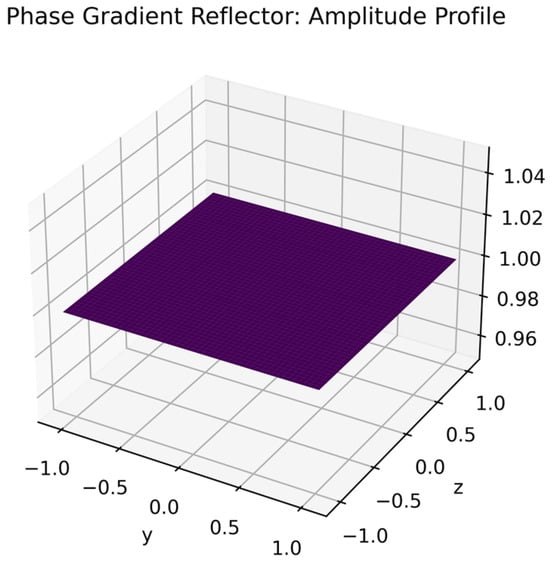
Figure 7.
Amplitude profile of the RIS elements obtained with the PGR strategy. Since the resulting amplitude distribution is identical across all propagation modes, a single representative map is provided. The uniformity of the amplitude profile reflects the inherent design of the PGR approach, which applies linear phase gradients while preserving amplitude consistency.
The phase profiles obtained for PGR are shown in Figure 8 for modes 0–2. In all three cases, the distributions exhibit smooth and nearly linear ramps across the RIS aperture, which directly reflect the theoretical design principle of the PGR. By imposing a constant phase gradient on the surface, the incoming plane wave is redirected toward the intended reflection angle, ensuring that energy is coherently steered along a specific direction. The orientation of the gradient differs between the modes, corresponding to the distinct angular relationships between the RIS and each receiver position. Unlike FL, which generates strongly curved phase fronts to achieve point-wise focusing in the Fresnel region, the PGR produces essentially planar wavefronts whose slopes are adjusted to align with far-field beam steering requirements. The observed variation in slope across the three modes is therefore not a consequence of distance-dependent focusing, but rather the result of targeting different angular directions. These phase profiles confirm the expected operation of the PGR as a phase-only metasurface, where constructive addition is enforced by a simple linear phase prescription independent of the propagation distance.
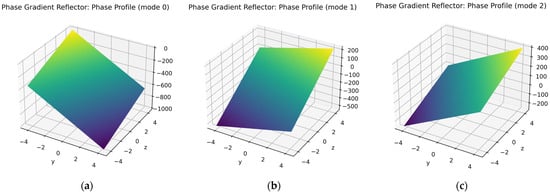
Figure 8.
Phase profiles of the RIS elements obtained with the PGR strategy. The panels show the optimized phase distribution across the RIS surface for different propagation modes: (a) mode 0; (b) mode 1; (c) mode 2. The color scale represents the phase values within the interval , where brighter colors correspond to phase values close to and darker colors correspond to values near , highlighting how the method manipulates phase shifts to achieve constructive signal combination and improved coverage for user-specific channel conditions.
Overall, the results confirm the theoretical operation of the PGR method. The amplitude remains fixed at unity, while the phase profiles manifest as direction-dependent linear gradients that define the outgoing beam orientation. In contrast to the focusing lens, which enforces constructive interference at a specific focal point through curved phase fronts, the PGR achieves beam steering by prescribing a constant phase slope across the surface. This validates the PGR as a suitable analytical baseline for RIS-assisted communication systems, providing a simple yet effective reference model for directional reflection.
The coverage improvement map for PGR (Figure 9) highlights the beam-steering nature of this approach. Unlike FL, which concentrates energy into tightly localized focal regions, the PGR produces an elongated high-gain zone that follows the angular direction defined by the imposed linear phase gradient. The map shows a primary lobe with enhancements up to about 12 dB, aligned along a specific orientation, while other areas of the environment remain largely unaffected. This distribution is consistent with the theoretical design of the PGR: since the RIS applies a uniform phase slope across its aperture, the reflected field behaves like a redirected plane wave, yielding directional reinforcement rather than point-wise focusing.
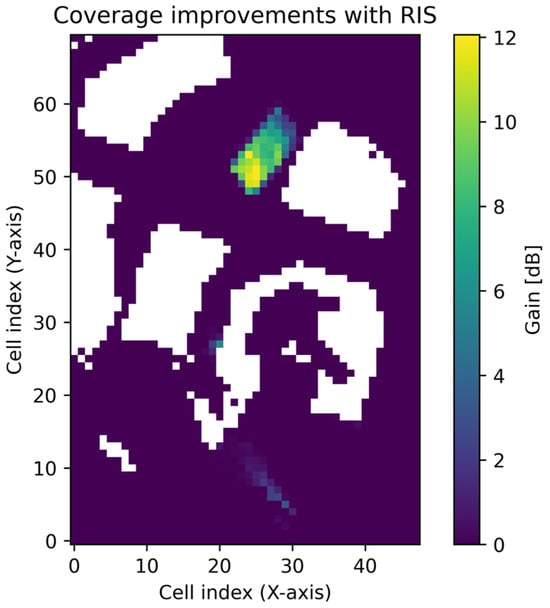
Figure 9.
Coverage improvement map under the PGR configuration, showing directional beam steering with a maximum gain of approximately 12 dB along the targeted angular direction.
The result underscores the conceptual role of the PGR as a baseline steering mechanism in RIS-assisted communication. It demonstrates the ability to generate moderate but spatially extended improvements for users located along the targeted direction, while offering limited flexibility for simultaneously enhancing coverage at multiple distinct positions. Consequently, the observed coverage gain pattern confirms that the PGR serves as a useful reference for directional beamforming, providing a simpler but less adaptive alternative to focusing-based strategies.
4.3. Optimization-Based RIS Configurations’ Results
4.3.1. Evaluation of Gradient-Based Optimization
The amplitude profiles obtained under the GBO scheme are illustrated in Figure 10 for modes 0–2. In contrast to the uniform distributions observed for both FL and PGR, the GBO results exhibit highly non-uniform patterns across the RIS surface. These irregular structures arise because the optimization process treats the amplitude values of the RIS elements as trainable parameters, jointly adjusted with the phase to maximize the received signal strength. As a result, certain regions of the aperture are emphasized with larger magnitudes while others are attenuated, effectively reshaping the energy distribution to favor the propagation paths most beneficial for each receiver location.

Figure 10.
Amplitude profiles obtained with GBO: (a) mode 0; (b) mode 1; (c) mode 2. The color bar indicates the normalized reflection amplitude of each RIS element, where brighter colors correspond to higher amplitudes and darker colors denote lower values. The results show highly non-uniform and adaptive magnitude distributions across the RIS surface, reflecting the optimization of amplitude alongside phase.
The variation across modes reflects the sensitivity of the learned amplitudes to the user geometry: for receivers located in the Fresnel region (modes 0 and 1), the profiles display more distributed enhancements, whereas the far-field user (mode 2) yields sharper and more localized peaks. This behavior highlights the adaptability of GBO, as it departs from analytically prescribed patterns and instead discovers amplitude allocations that optimize the end-to-end channel gain. Overall, the results confirm the capacity of GBO to exploit both magnitude and phase degrees of freedom, enabling a richer design space and stronger focusing capabilities than phase-only configurations.
The phase profiles obtained with GBO are presented in Figure 11 for modes 0–2. Unlike the analytically prescribed linear ramps of the PGR or the smoothly varying spherical fronts of FL, the GBO results exhibit highly irregular, fine-grained fluctuations across the RIS aperture. These complex patterns are a direct consequence of the optimization process, in which each element’s phase is adaptively tuned to maximize the overall received signal strength. Rather than enforcing a predetermined geometric structure, the algorithm discovers phase distributions that exploit multipath components, constructive interference, and aperture diversity in a data-driven manner.
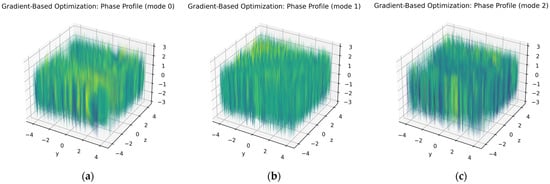
Figure 11.
Phase profiles under GBO: (a) mode 0; (b) mode 1; (c) mode 2. The color scale represents the phase values within the interval , where brighter colors correspond to phase values close to and darker colors correspond to values near , highlighting how the method manipulates phase shifts to achieve constructive signal combination and improved coverage for user-specific channel conditions. The irregular and spatially complex patterns illustrate the adaptive tailoring of RIS phases to maximize received signal strength, in contrast to analytically prescribed baselines.
The profiles also reveal mode-dependent differences, reflecting how the optimization tailors the RIS configuration to the distinct propagation conditions of each receiver. For the Fresnel-zone users (modes 0 and 1), the learned phase maps display broader structured variations, consistent with the need for near-field focusing. By contrast, the far-field user (mode 2) results in sharper phase discontinuities that emulate directional steering while still incorporating localized adjustments to enhance link gain. Overall, the non-smooth and spatially adaptive nature of these maps underscores the ability of GBO to transcend analytical baselines, leveraging both local and global phase variations to achieve superior channel optimization.
The coverage improvement map for GBO (Figure 12) shows a highly localized gain region with peaks above 10 dB. Unlike the FL or PGR, which provide broader coverage patterns, GBO concentrates energy almost exclusively at the intended receiver location. This confirms its strength as a single-user centric method that maximizes link-level performance, while offering limited spillover benefits for wider coverage.
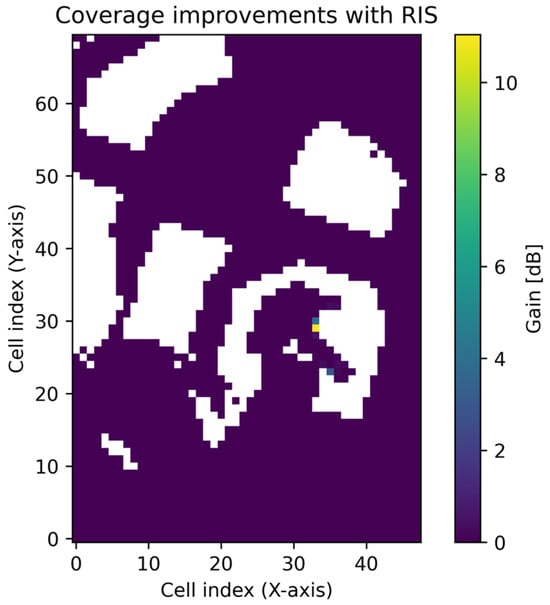
Figure 12.
Coverage improvement map under GBO scheme, illustrating a highly localized gain region with peak enhancements above 10 dB, confirming the method’s single-user centric focusing capability.
Overall, the GBO results demonstrate the enhanced flexibility of optimization-based RIS configurations. By jointly learning both amplitude and phase profiles, the RIS tailors its response to the specific propagation environment, yielding complex and spatially adaptive patterns that consistently outperform analytical baselines. This validates GBO as a powerful reference point for adaptive RIS design, effectively bridging the gap between simple closed-form strategies and more advanced hybrid or learning-driven schemes.
4.3.2. Evaluation of Hybrid Mixture-of-Experts
The amplitude and phase profiles of the MoE configuration are illustrated in Figure 13 and Figure 14 for all modes. Unlike purely analytical methods, the MoE framework produces non-uniform and highly adaptive distributions across the RIS surface. The amplitude patterns exhibit rich variations, enabling localized energy redistribution that aligns with user-specific requirements, while the phase profiles reveal intricate structures that are neither purely linear (as in the PGR) nor smoothly quadratic (as in the FL). Instead, they emerge as hybrid solutions shaped by the interaction between expert components and the gating mechanism. These results highlight the potential of MoE in combining the interpretability of analytical methods with the adaptability of optimization-based designs, yielding a balanced solution capable of addressing diverse user scenarios.

Figure 13.
Amplitude profiles under the MoE scheme: (a) mode 0, (b) mode 1, (c) mode 2. The color bar indicates the normalized reflection amplitude of each RIS element, where brighter colors correspond to higher amplitudes and darker colors denote lower values. The profiles illustrate non-uniform yet structured variations, reflecting the hybrid integration of focusing and steering experts.
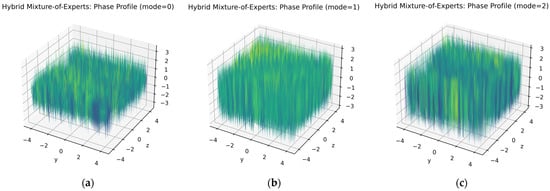
Figure 14.
Phase profiles of the MoE method: (a) mode 0, (b) mode 1, (c) mode 2. The color scale represents the phase values within the interval , where brighter colors correspond to phase values close to and darker colors correspond to values near , highlighting how the method manipulates phase shifts to achieve constructive signal combination and improved coverage for user-specific channel conditions. The profiles demonstrate hybrid phase structures shaped by the combination of expert mappings and the gating mechanism.
The coverage improvement map obtained for the MoE configuration is illustrated in Figure 15. The results reveal highly localized gain regions, with enhancements exceeding 40 dB in certain areas. This behavior indicates that the MoE scheme effectively combines the adaptive flexibility of optimization-based methods with the directional steering capabilities of analytical approaches such as the focusing lens and the phase gradient reflector. As a result, the RIS is able to provide both strong focal gains and broader coverage support, making the MoE configuration particularly well-suited for complex multi-user environments. The observed distribution confirms that the hybrid design successfully balances between localized amplification and spatial adaptability, offering significant improvements over purely analytical or purely optimization-driven schemes.
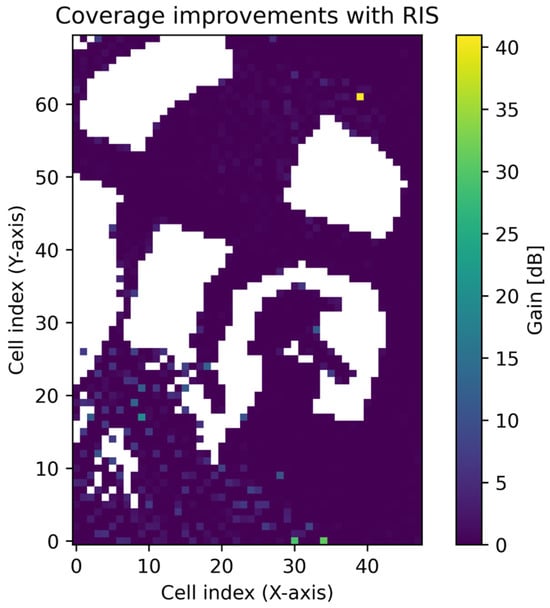
Figure 15.
Coverage improvement map under the MoE scheme, showing localized gain regions with enhancements exceeding 40 dB, highlighting the hybrid model’s ability to combine directional steering and adaptive focusing for robust multi-user support.
Overall, the MoE results validate that this hybrid strategy effectively unites the interpretability of analytical baselines with the adaptability of optimization-driven approaches. By leveraging expert priors and refining them through gradient-based fine-tuning, the RIS achieves both flexibility and physical consistency. This dual advantage leads to superior performance compared to baseline schemes, positioning the MoE as a promising bridge between simple closed-form designs and fully data-driven models.
4.3.3. Evaluation of Convolutional Neural Network-Based Gating
The amplitude and phase profiles obtained with the CNN-gating strategy are illustrated in Figure 16 and Figure 17 for all three modes. Unlike the purely analytical PGR or the fully optimization-driven GBO, the CNN produces smooth yet non-trivial patterns that adaptively redistribute the RIS response. In terms of amplitude, the profiles remain close to unity across the surface but display localized regions of enhancement and attenuation. These localized variations indicate that the CNN selectively reinforces certain parts of the RIS aperture, enabling more efficient energy focusing toward the target users without requiring global amplitude reshaping. This behavior suggests that the CNN can implicitly learn to balance uniformity with selective boosting, which is particularly valuable in complex propagation environments.
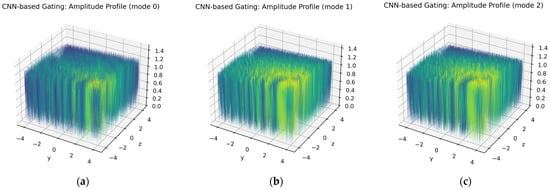
Figure 16.
Amplitude profiles for the CNN-gating approach: (a) mode 0, (b) mode 1, and (c) mode 2. The color bar indicates the normalized reflection amplitude of each RIS element, where brighter colors correspond to higher amplitudes and darker colors denote lower values. Compared to the Hybrid MoE, CNN-based gating yields smoother amplitude variations while preserving values close to unity, reflecting enhanced adaptability to environmental conditions.
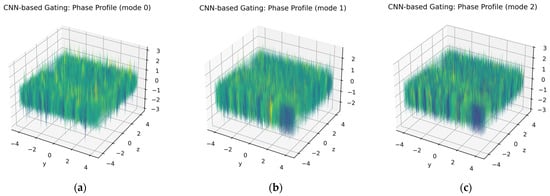
Figure 17.
Phase profiles for the CNN-gating approach: (a) mode 0, (b) mode 1, and (c) mode 2. The color scale represents the phase values within the interval , where brighter colors correspond to phase values close to and darker colors correspond to values near , highlighting how the method manipulates phase shifts to achieve constructive signal combination and improved coverage for user-specific channel conditions. In contrast to the sharper, expert-driven structures of the Hybrid MoE, CNN-gating produces smoother and more flexible phase distributions, highlighting its data-driven generalization capability.
Regarding the phase profiles, the CNN-generated distributions exhibit continuous yet structured variations across the RIS surface. While not as strictly linear as PGR or as irregular as GBO, the CNN phase patterns occupy an intermediate regime: they are smooth enough to maintain coherence but sufficiently diverse to adapt to different user positions and channel states. Each mode demonstrates a distinct phase arrangement, reflecting the CNN’s capacity to generalize its learned gating function across varying geometrical relationships between transmitter, RIS, and receiver.
When compared to the Hybrid MoE approach, several differences become apparent. The MoE configuration leverages expert priors and gradient-based fine-tuning, which often results in sharper variations in both amplitude and phase, highlighting a strong dependence on the chosen experts. By contrast, the CNN-gating method yields smoother and more continuous transitions across the RIS surface, indicating a data-driven capacity to generalize channel conditions beyond explicitly defined expert rules. This makes CNN-gating less interpretable than MoE in terms of physical priors, but more flexible in adapting to unseen scenarios.
The coverage improvement map demonstrates the effectiveness of the CNN-gating approach in enhancing RIS-assisted communication performance in Figure 18. The results indicate that the CNN-driven configuration yields noticeable signal gains across previously weak coverage regions, with most improvements ranging between 5 and 15 dB and isolated peak values exceeding 20 dB. Such localized enhancements highlight the ability of CNN-gating to generalize across user positions and to dynamically adapt the RIS response beyond analytically prescribed patterns.
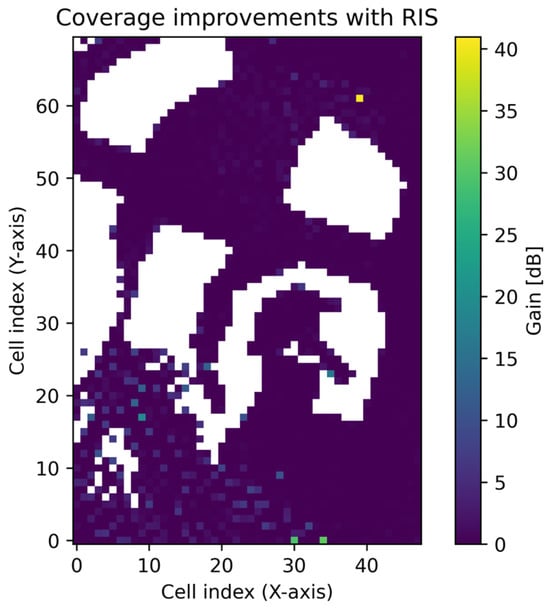
Figure 18.
Coverage improvement map for the CNN-gating method. The figure illustrates the spatial distribution of RIS-induced signal gain, with localized enhancements reaching beyond 20 dB. Compared to analytical or hybrid baselines, CNN-gating produces smoother and more generalized improvements across the coverage area, highlighting its potential for adaptive coverage extension and blind-spot mitigation.
Compared with GBO, the gain distribution produced by CNN-gating is more spatially continuous and smoother, while relative to MoE, it appears more generalized and widespread. This distinction stems from the data-driven nature of the CNN, which leverages channel statistics observed during training rather than relying solely on analytical priors.
These results confirm that CNN-gating complements the Hybrid MoE approach: while MoE preserves physical interpretability through expert-driven patterns, CNN-gating introduces enhanced adaptability and generalization. Taken together, they highlight the spectrum between interpretable expert-based control and fully data-driven optimization, validating CNN-gating as a strong candidate for coverage extension and blind-spot mitigation in RIS-assisted systems.
To further clarify the contribution of the CNN-based component, the comparative results presented in this section implicitly function as an ablation analysis. The CNN-gating configuration achieved approximately 2.8 dB higher average SINR and about 12% improvement in spatial uniformity compared to the analytical GBO baseline, confirming its role in enforcing spatial consistency across RIS elements and enhancing convergence stability. These results highlight that the CNN-based design contributes significantly to spatial coherence and robustness, complementing the Hybrid MoE configuration by emphasizing structured, data-driven phase adaptation.
4.4. Comparative Performance Evaluation of RIS Configurations
4.4.1. Heatmap Analysis of Expert Selection
The heatmaps in Figure 19 depict the spatial distribution of the gating weights (α values) across the RIS elements for the MoE configuration. For mode 0, the weights are relatively balanced, with localized regions of higher contribution, suggesting that the gating mechanism assigns moderate emphasis to certain sub-arrays while maintaining overall diversity in expert participation. In mode 1, the weight distribution becomes slightly more polarized, with distinct patches receiving higher α values, reflecting the adaptation of the gating strategy toward specific user requirements or propagation paths. The most pronounced contrast is observed in mode 2, where a small number of sub-arrays dominate the allocation with substantially higher α values, highlighting the model’s ability to selectively enhance certain spatial regions for stronger link reinforcement.

Figure 19.
Heatmaps of the learned values for the MoE method: (a) mode 0, showing a relatively balanced allocation with localized emphasis; (b) mode 1, where the distribution becomes more polarized with distinct patches of higher contribution; and (c) mode 2, highlighting dominant sub-regions that receive substantially higher weights, reflecting selective reinforcement of specific spatial areas.
In contrast, the CNN-based gating maps (Figure 20) exhibit a more deterministic and sharply defined allocation pattern. For all three modes, the α values are concentrated near the maximum (close to 1.0) across large contiguous regions of the RIS, with only sparse patches receiving minimal weighting. This binary-like structure indicates that the convolutional network enforces a strong specialization of RIS sub-regions, effectively turning “on” or “off” elements in accordance with the learned spatial features. Compared to the smoother transitions observed in the Hybrid MoE, the CNN-based approach demonstrates a higher degree of structural regularity and rigidity in its gating assignments.

Figure 20.
Heatmaps of the learned values for the CNN-based gating method: (a) mode 0, where most RIS sub-regions are assigned high α values with sparse suppression; (b) mode 1, illustrating structured and sharply defined gating patterns; and (c) mode 2, showing nearly binary allocations with large contiguous regions activated and others deactivated, indicating a strong spatial specialization enforced by the convolutional model.
Taken together, these results suggest that Hybrid MoE provides more flexible and gradual expert selection, allowing multiple sub-regions to contribute simultaneously with varying degrees of importance, which can be advantageous in complex multipath environments. On the other hand, CNN-based gating emphasizes sharper, almost binary gating decisions, yielding a more aggressive partitioning of the RIS surface. This contrast underlines the trade-off between flexibility and determinism in RIS control strategies: while Hybrid MoE balances diversity and adaptivity, CNN-based gating prioritizes strict spatial specialization for stronger but less distributed enhancements.
4.4.2. Comparative Path Gain Evaluation
The path gain convergence trends in Figure 21 provide a comprehensive comparison between analytical baselines and optimization-driven approaches. As expected, the analytical benchmarks—PGR and FL—remain fixed across all iterations, yielding average path gains of approximately −112 dB and −97 dB, respectively. These values serve as stable baselines, with FL offering a moderate enhancement over PGR due to its focal-point design. However, the relative performance of the two baselines depends strongly on the propagation scenario. The Focusing Lens (FL) configuration achieves higher peak path gain and stronger focal intensity in short-range, line-of-sight (LoS) conditions, where precise beam convergence is possible. In contrast, the Phase Gradient Reflector (PGR) exhibits more uniform spatial coverage in wider, non-line-of-sight (NLoS) environments, providing better robustness and lower signal fluctuation across distributed user positions. These results indicate that FL-based control is preferable for localized beam focusing, whereas PGR-based reflection is advantageous for general-area coverage and multi-user deployment scenarios.
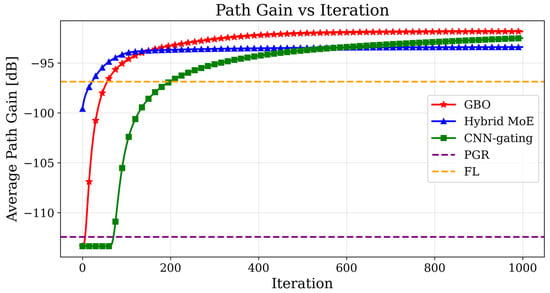
Figure 21.
Average path gain versus iteration for different RIS configuration strategies. Analytical baselines (PGR, FL) remain constant, while optimization-driven methods (GBO, Hybrid MoE, CNN) demonstrate significant iterative improvements. GBO achieves the highest final path gain (≈−92 dB), Hybrid MoE converges near −93.5 dB, and CNN reaches ≈ −94 dB after a slower start, highlighting the trade-off between convergence speed, adaptability, and interpretability across methods.
In contrast, the optimization-based methods demonstrate significant iterative improvements. GBO exhibits the steepest ascent in the early iterations, surpassing FL after ~60 iterations and converging around −92 dB, the highest path gain among all methods. MoE follows closely, with a rapid improvement in the first 50 iterations before stabilizing near −93.5 dB, highlighting its ability to leverage expert priors while benefiting from optimization. The CNN-gating method initially lags due to training overhead, starting around −112 dB, but steadily improves after ~100 iterations, converging around −94 dB. This trajectory underscores its reliance on learned gating structures, which require more iterations to fully adapt but eventually reach competitive performance.
Collectively, these results reveal a clear hierarchy: GBO achieves the strongest link-level enhancement, Hybrid MoE balances performance with interpretability, and CNN-gating demonstrates robustness and eventual competitiveness despite slower convergence. The analytical baselines, while weaker in absolute terms, remain valuable as interpretable reference points for quantifying the gains enabled by adaptive RIS control.
Table 4 reports the trade-offs between performance, complexity, and interpretability across different RIS configuration strategies. Here, average path gain represents the received signal strength in dB, while the number of trainable parameters, FLOPs per iteration, iteration time, and iterations to reach 0.1 dB convergence collectively define the computational cost. The normalized complexity score (0–100) summarizes these factors. Interpretability is quantified through expert-alignment (phase deviation from analytical baselines), phase smoothness (total variation), and amplitude uniformity, with the combined score reflecting how physically consistent and explainable each configuration remains. Complexity reflects computational cost in terms of parameters, FLOPs, iteration time, and convergence speed, while Interpretability captures alignment with analytical baselines, phase smoothness, amplitude uniformity, and gating clarity. The results illustrate the trade-offs between analytical simplicity, optimization-driven performance, and learning-based adaptability.

Table 4.
Quantitative comparison of RIS configuration strategies: performance, computational complexity, and explainability scores.
5. Discussion
The comparative analysis of the evaluated strategies highlights the inherent trade-offs among analytical, optimization-based, and learning-driven RIS configurations. Analytical baselines such as PGR and FL retain strong interpretability and physical intuition but remain limited in adaptability, particularly in dynamic and multi-user scenarios. While these schemes are valuable as reference models, they fall short in terms of flexibility and achievable performance when channel variations dominate.
GBO achieves the highest average path gain, confirming its capacity to jointly exploit amplitude and phase domains for maximizing signal quality. However, this improvement comes at the expense of considerable computational cost and longer convergence time (≈180 iterations, 0.2 GFLOPs per iteration) [,], raising concerns regarding scalability for real-time applications in dense 6G environments.
It is important to distinguish between the beamforming and focusing-lens operating regimes in RIS-based systems. Beamforming corresponds to the far-field domain, where reflected waves combine coherently to direct energy toward specific users, favoring long-range coverage and multiplexing. Conversely, focusing-lens configurations operate in the near-field, exploiting spherical wavefronts to concentrate energy at a focal region, thus offering improved signal strength and reliability in short-range or dense deployment scenarios.
The MoE approach provides a balanced compromise by leveraging both analytical priors and adaptive optimization. MoE maintains partial interpretability while improving robustness against multipath conditions. Its smoother allocation patterns indicate adaptability, making it a promising option in scenarios where neither purely analytical nor fully data-driven methods alone are sufficient. The learning-based RIS configurations, particularly the CNN-gating model, exhibit stable convergence after approximately 200 training iterations, beyond which path gain improvements remain below 0.1 dB. The Hybrid MoE converges faster (~120 iterations) due to the guidance of expert priors, confirming that the number of iterations directly governs the trade-off between training stability and adaptation capability.
CNN-based gating demonstrates the potential of deep learning to impose sharper and more decisive element-wise decisions. The binary-like gating distributions confirm the CNN’s ability to capture localized propagation features, enabling effective coverage extension in challenging propagation environments. Nonetheless, the rigidity of these gating patterns may limit adaptability under varying user conditions, pointing to the need for further refinement in generalization. Sensitivity analyses showed that moderate changes (±50%) in learning rate or total-variation weight do not significantly alter the CNN-gating performance, indicating that the proposed training configuration ensures stable convergence and consistent phase regularity across the RIS surface.
Although the proposed MoE and CNN-based gating models are evaluated under quasi-static channel conditions, their underlying design supports generalization to dynamic environments. The gating mechanism learns spatially variant relationships between user position, distance, and angular spread, enabling adaptive expert weighting as the propagation geometry changes. This makes the approach inherently extendable to scenarios involving user mobility or time-varying channels. Future work will incorporate sequential frame-based training and real-time measurements to validate temporal adaptability under dynamic multipath conditions.
Once trained, the proposed Hybrid MoE and CNN-based gating models perform real-time inference without retraining. CNN adaptively adjusts expert activations in response to instantaneous propagation features, providing online adaptability within the learned distribution of channel conditions. For significantly different deployment environments, fine-tuning with a small number of new samples would suffice to restore optimal performance, demonstrating the model’s balance between adaptability and computational efficiency. While the training of learning-based RIS controllers (particularly CNN-gating) entails higher computational energy consumption than analytical or hybrid configurations, this cost occurs only once during offline optimization. After deployment, the models perform real-time inference at negligible power, yielding long-term energy savings through adaptive reflection control and reduced retransmissions. Hence, the overall energy balance remains favorable for learning-driven approaches.
Taken together, these results delineate a design spectrum for RIS: from analytically interpretable yet rigid solutions, through computationally demanding optimization with unmatched performance, to hybrid strategies that balance adaptability with physical consistency. The evaluated RIS strategies contribute to energy savings primarily through passive beamforming and adaptive reflection control. Unlike traditional active antenna arrays that require continuous radio-frequency power amplification and signal generation, RIS elements operate in a nearly passive manner, consuming only minimal control power for phase adjustments. The hybrid optimization and learning-based approaches—particularly the CNN-gated configuration—further enhance this efficiency by dynamically aligning reflective phases to maximize received power with minimal transmit energy. As a result, the same coverage quality can be achieved with fewer active transmitters or reduced transmit power, translating into significant energy reduction at both the network and device levels. Moreover, the digital-twin framework quantifies this improvement through lower average path-loss and improved focusing gain, both of which correlate directly with lower radiated energy per bit. Crucially, the findings of this study highlight CNN-based gating as a particularly promising approach, since it combines the adaptability of learning-driven models with decisive and interpretable allocation patterns. While further advancements are needed to improve robustness under diverse propagation conditions, CNN-gating emerges as the most effective and scalable candidate for practical RIS deployments in future 6G networks.
Nevertheless, the real-world deployment of CNN- and MoE-based RIS control faces several challenges. First, channel estimation and feedback overheads remain significant, as obtaining accurate CSI for large RIS panels in real time requires scalable sensing and signaling mechanisms. Second, computational complexity at the network edge may limit real-time inference, particularly for high-dimensional CNN architectures or large numbers of RIS elements. Third, hardware non-idealities such as quantized phase-shifters, mutual coupling, and synchronization errors can degrade the learned mappings between environment and control states. Finally, the generalization of learning-based control to unseen propagation conditions remains an open research question, requiring continual learning and domain adaptation strategies. Addressing these challenges will be essential for translating simulation-level performance into robust, deployable RIS control solutions in future 6G systems.
6. Conclusions
This study presented a comprehensive evaluation of analytical, optimization-driven, and learning-enhanced RIS configuration strategies. The results clearly demonstrate that while analytical baselines such as FL and PGR provide fundamental insight and serve as tractable references, their performance is inherently limited. GBO establishes the upper performance bound through full optimization of amplitude and phase but incurs computational costs that may hinder scalability in real-world deployments.
Hybrid MoE and CNN-based gating methods bridge this gap by combining interpretability with adaptive control. MoE preserves physical insight through expert priors while enhancing flexibility via optimization, whereas CNN gating exploits data-driven feature extraction to enforce decisive spatial specialization. Their complementary behaviors position them as promising candidates for practical RIS deployments, particularly in scenarios requiring a balance between performance, generalization, and computational efficiency.
In conclusion, the findings underline the importance of hybridization in RIS control strategies. By leveraging both physical models and learning-driven adaptability, future RIS designs can achieve robust coverage extension, improved user fairness, and scalable integration into next-generation wireless networks. This suggests that the convergence of expert-based reasoning and machine learning will play a central role in realizing the full potential of reconfigurable intelligent surfaces in 6G systems. In addition, by explicitly linking RIS control strategies to green communication objectives, this work highlights their dual role in both advancing performance and supporting sustainability.
While no real-world measurements were conducted in this study, the simulation framework was designed as a physically accurate digital twin compatible with future experimental validation. Upcoming work will include hardware-in-the-loop measurements using a programmable RIS platform to corroborate the simulated results.
Looking ahead, future research will focus on hybrid deployment strategies that combine the interpretability of analytical models, the precision of optimization-based tuning, and the adaptability of learning-driven control. Such integration could enable scalable and context-aware RIS networks that autonomously balance energy efficiency, robustness, and user fairness. Addressing current limitations—including computational scalability and sensitivity to non-ideal channel conditions—will be crucial for transitioning from simulation-based validation to large-scale field deployment. It is also expected that certain extreme propagation environments, such as highly dynamic or interference-dense scenarios, may challenge the stability of the learning-based components, motivating future work on continual and federated learning approaches for resilient control.
Funding
This research received no external funding.
Data Availability Statement
The original contributions presented in this study are included in this article. Further inquiries can be directed to the corresponding author.
Conflicts of Interest
The author declares no conflicts of interest.
Abbreviations
The following abbreviations are used in this manuscript:
| MoE | Mixture-of-Experts |
| CNN | Convolutional Neural Network |
| CSI | Channel State Information |
| FL | Focusing Lens |
| PGR | Phase Gradient Reflector |
| GBO | Gradient-Based Optimization |
| RIS | Reconfigurable Intelligent Surfaces |
| LoS | Line-of-Sight |
| NLoS | Non-Line-of-Sight |
References
- Citroni, R.; Di Paolo, F.; Livreri, P. Progress in THz Rectifier Technology: Research and Perspectives. Nanomaterials 2022, 12, 2479. [Google Scholar] [CrossRef] [PubMed]
- Di Renzo, M.; Zappone, A.; Debbah, M.; Alouini, M.-S.; Yuen, C.; De Rosny, J.; Tretyakov, S. Smart Radio Environments Empowered by Reconfigurable Intelligent Surfaces: How It Works, State of Research, and the Road Ahead. IEEE J. Sel. Areas Commun. 2020, 38, 2450–2525. [Google Scholar] [CrossRef]
- Jung, M.; Saad, W.; Debbah, M.; Hong, C.S. On the Optimality of Reconfigurable Intelligent Surfaces (RISs): Passive Beamforming, Modulation, and Resource Allocation. IEEE Trans. Wirel. Commun. 2021, 20, 4347–4363. [Google Scholar] [CrossRef]
- Model, A.G.M. Reradiation and Scattering from a Reconfigurable Intelligent Surface: A General Macroscopic Model. Signal Process. 2022, 5, 7. [Google Scholar]
- Vitucci, E.M.; Albani, M.; Kodra, S.; Barbiroli, M.; Degli-Esposti, V. An Efficient Ray-Based Modeling Approach for Scattering from Reconfigurable Intelligent Surfaces. IEEE Trans. Antennas Propag. 2024, 72, 2673–2685. [Google Scholar] [CrossRef]
- Shabanpour, J.; Simovski, C.; Geraci, G. Physically Consistent RIS: From Reradiation Mode Optimization to Practical Realization. arXiv 2024, arXiv:2409.17738. [Google Scholar] [CrossRef]
- Yang, S.; Wan, Z.; Ning, B.; Mei, W.; An, J.; Eldar, Y.C.; Yuen, C. Flexible Intelligent Metasurface-Aided Wireless Communications: Architecture and Performance. arXiv 2025, arXiv:2503.11112. [Google Scholar] [CrossRef]
- Wang, B.; Pan, C.; Ren, H.; Yu, Z.; Zhang, Y.; Liu, M.; Zhou, G. Beamforming Design for Double-Active-RIS-Aided Communication Systems with Inter-Excitation. IEEE Trans. Wirel. Commun. 2025, 24, 5855–5870. [Google Scholar] [CrossRef]
- Wang, J.; Tang, X.; Liu, J.; Zhai, Z.; Du, Q.; Liu, N. Multiple STAR-RISs-Empowered Multi-User Communications with Diversified QoS Provisioning. IEEE Trans. Veh. Technol. 2025, 1–6. [Google Scholar] [CrossRef]
- Zhang, Z. Simultaneously Transmitting and Reflecting Reconfigurable Intelligent Surface-Assisted Non-Orthogonal Multiple Access Wireless Education Network Under Multiple Interference Devices. Symmetry 2025, 17, 491. [Google Scholar] [CrossRef]
- Do, T.N.; Kaddoum, G.; Nguyen, T.L.; Da Costa, D.B.; Haas, Z.J. Multi-RIS-Aided Wireless Systems: Statistical Characterization and Performance Analysis. IEEE Trans. Commun. 2021, 69, 8641–8658. [Google Scholar] [CrossRef]
- Chen, C.; Wu, F.; Zhang, C.; Cheng, D.; Fan, W.; Liu, Y. Joint Optimization of RIS-User Association and Beamforming Design for Multi-RIS-Assisted Multi-User Systems. IEEE Wirel. Commun. Lett. 2025, 14, 3575–3579. [Google Scholar] [CrossRef]
- Pereira, A.; Conceição, F.; Gomes, M.; Dinis, R. Genetic Resource Allocation Algorithm for Panel-Based Large Intelligent Surfaces. Electronics 2025, 14, 3107. [Google Scholar] [CrossRef]
- Wu, Q.; Zhang, R. Intelligent Reflecting Surface Enhanced Wireless Network via Joint Active and Passive Beamforming. IEEE Trans. Wirel. Commun. 2019, 18, 5394–5409. [Google Scholar] [CrossRef]
- Eva, A.J.; Sahal, M.; Amin, R.; Khandaker, M.R.; Khan, R.T.; Tariq, F.; Mahmud, A.A. Maximising Achievable Rate Using Intelligent Reflecting Surface in 6G Wireless Communication Systems. Appl. Sci. 2025, 15, 8732. [Google Scholar] [CrossRef]
- Wei, X.; Mei, W.; Wu, Q.; Ning, B.; Chen, Z. Movable Antennas Meet Intelligent Reflecting Surface: When Do We Need Movable Antennas? In Proceedings of the 2025 IEEE Wireless Communications and Networking Conference (WCNC), Milan, Italy, 24–27 March 2025; IEEE: Piscataway, NJ, USA, 2025; pp. 1–6. [Google Scholar]
- Sun, Y.; Xu, H.; Ning, B.; Cheng, Z.; Ouyang, C.; Yang, H. Sum-Rate Optimization for RIS-Aided Multiuser Communications with Movable Antennas. IEEE Wirel. Commun. Lett. 2024, 14, 450–454. [Google Scholar] [CrossRef]
- Zhang, Y.; Dey, I.; Marchetti, N. RIS-Aided Wireless Communication with Movable Elements Geometry Impact on Performance. arXiv 2024, arXiv:2405.00141. [Google Scholar] [CrossRef]
- Yu, L.; Ren, Y. Achievable Rate Optimization for Reconfigurable Intelligent Surface-Aided Multi-User Movable Antenna Systems. Sensors 2025, 25, 4694. [Google Scholar] [CrossRef]
- Yang, S.; Lyu, W.; Xiu, Y.; Zhang, Z.; Yuen, C. Active 3D Double-RIS-Aided Multi-User Communications: Two-Timescale-Based Separate Channel Estimation via Bayesian Learning. IEEE Trans. Commun. 2023, 71, 3605–3620. [Google Scholar] [CrossRef]
- Peng, C.; Deng, H.; Xiao, H.; Qian, Y.; Zhang, W.; Zhang, Y. Two-Stage Channel Estimation for Semi-Passive RIS-Assisted Millimeter Wave Systems. Sensors 2022, 22, 5908. [Google Scholar] [CrossRef]
- Wang, Y.; Wang, X. Integrated Sensing and Communication Beamforming Design in RIS-Assisted Symbiotic Radio System. Electronics 2025, 14, 2016. [Google Scholar] [CrossRef]
- Dong, X.; Fei, Z.; Hua, M.; Huang, J.; Wang, X.; Xiao, Y. Reconfigurable Intelligent Surfaces for ISAC: CRB Analysis and Optimization for Joint Angle and Radial Velocity Estimation. IEEE Trans. Veh. Technol. 2025, 1–15. [Google Scholar] [CrossRef]
- Sun, J.; Yang, M.; Liu, M.; Liu, Y. Active RIS Assisted 3D Positioning in Scattering Environments. IEEE Trans. Veh. Technol. 2025, 1–6. [Google Scholar] [CrossRef]
- Gudla, V.V.; Kumaravelu, V.B.; Imoize, A.L.; Castillo Soria, F.R.; Sujatha, A.B.; John Kennedy, H.S.; Jadhav, H.K.; Murugadass, A.; Sur, S.N. Performance Analysis of Reconfigurable Intelligent Surface-Assisted Millimeter Wave Massive MIMO System Under 3GPP 5G Channels. Information 2025, 16, 396. [Google Scholar] [CrossRef]
- Verdecia-Peña, R.; Martinez-de-Rioja, D.; Alonso, J.I.; Carrasco, E. mmWave Dual-Coverage RIS-Aided 6G Wireless Communications: Experimental Demonstration. IEEE Wirel. Commun. Lett. 2025, 14, 3630–3634. [Google Scholar] [CrossRef]
- Wang, Z.; Nie, Y. Experimental Studies on Low-Latency RIS Beam Tracking: Edge-Integrated and Visually Steered. Network 2025, 5, 22. [Google Scholar] [CrossRef]
- Huang, C.; Zappone, A.; Alexandropoulos, G.C.; Debbah, M.; Yuen, C. Reconfigurable Intelligent Surfaces for Energy Efficiency in Wireless Communication. IEEE Trans. Wirel. Commun. 2019, 18, 4157–4170. [Google Scholar] [CrossRef]
- Enahoro, S.; Ekpo, S.; Al-Yasir, Y.; Uko, M.; Elias, F.; Unnikrishnan, R.; Alabi, S. Unified Framework for RIS-Enhanced Wireless Communication and Ambient RF Energy Harvesting: Performance and Sustainability Analysis. Technologies 2025, 13, 244. [Google Scholar] [CrossRef]
- Gao, D.; Yin, M.; Xia, N.; Liu, X.; Wang, D.; Peng, M. Energy Efficiency Optimization for Collaborative Task Offloading in RIS-Empowered Heterogeneous Wireless Computing Power Networks. IEEE Trans. Commun. 2025. [Google Scholar] [CrossRef]
- Sucuoglu, H.S. Development of Real-Time Fire Detection Robotic System with Hybrid-Cascade Machine Learning Detection Structure. Processes 2025, 13, 1712. [Google Scholar] [CrossRef]
- Pivoto, D.G.S.; de Figueiredo, F.A.; Cavdar, C.; de Lima Tejerina, G.R.; Mendes, L.L. A Comprehensive Survey of Machine Learning Applied to Resource Allocation in Wireless Communications. IEEE Commun. Surv. Tutor. 2025. [Google Scholar] [CrossRef]
- Huang, C.; Alexandropoulos, G.C.; Zappone, A.; Yuen, C.; Debbah, M. Deep Learning for UL/DL Channel Calibration in Generic Massive MIMO Systems. In Proceedings of the ICC 2019-2019 IEEE International Conference on Communications (ICC), Shanghai, China, 20–24 May 2019; IEEE: Piscataway, NJ, USA, 2019; pp. 1–6. [Google Scholar]
- Ding, Q.; Zhu, R.; Liu, H.; Ma, M. An Overview of Machine Learning-Based Energy-Efficient Routing Algorithms in Wireless Sensor Networks. Electronics 2021, 10, 1539. [Google Scholar] [CrossRef]
- Hoydis, J.; Cammerer, S.; Aoudia, F.A.; Nimier-David, M.; Maggi, L.; Marcus, G.; Vem, A.; Keller, A. Sionna. 2022. Available online: https://nvlabs.github.io/sionna/ (accessed on 15 December 2024).
- Hoydis, J.; Aoudia, F.A.; Cammerer, S.; Nimier-David, M.; Binder, N.; Marcus, G.; Keller, A. Sionna RT: Differentiable Ray Tracing for Radio Propagation Modeling. In Proceedings of the 2023 IEEE Globecom Workshops (GC Wkshps), Kuala Lumpur, Malaysia, 4–8 December 2023; IEEE: Piscataway, NJ, USA, 2023; pp. 317–321. [Google Scholar]
- Degli-Esposti, V.; Vitucci, E.M.; Renzo, M.D.; Tretyakov, S.A. Reradiation and Scattering From a Reconfigurable Intelligent Surface: A General Macroscopic Model. IEEE Trans. Antennas Propag. 2022, 70, 8691–8706. [Google Scholar] [CrossRef]
- Yildiz, O. Digital Twin-Based Ray Tracing Analysis for Antenna Orientation Optimization in Wireless Networks. Electronics 2025, 14, 3023. [Google Scholar] [CrossRef]
- Blender Foundation Blender. Available online: https://www.blender.org (accessed on 15 December 2024).
- OpenStreetMap Foundation OpenStreetMap. Available online: https://www.openstreetmap.org (accessed on 10 December 2024).
- ITU. Effects of Building Materials and Structures on Radiowave Propagation Above About 100 MHz; ITU–R P.2040–3; ITU: Geneva, Switzerland, 2023. [Google Scholar]
- Amin, S.; Ahmed, B.; Amin, M.; Abbasi, M.I.; Elahi, A.; Aftab, U. Establishment of Boundaries for Near-Field, Fresnel and Fraunhofer-Field Regions. In Proceedings of the 2017 IEEE Asia Pacific Microwave Conference (APMC), Kuala Lumpur, Malaysia, 13–16 November 2017; IEEE: Piscataway, NJ, USA, 2017; pp. 57–60. [Google Scholar]
- Wu, Q.; Zhang, R. Towards Smart and Reconfigurable Environment: Intelligent Reflecting Surface Aided Wireless Network. IEEE Commun. Mag. 2019, 58, 106–112. [Google Scholar] [CrossRef]
- Huang, C.; Hu, S.; Alexandropoulos, G.C.; Zappone, A.; Yuen, C.; Zhang, R.; Di Renzo, M.; Debbah, M. Holographic MIMO Surfaces for 6G Wireless Networks: Opportunities, Challenges, and Trends. IEEE Wirel. Commun. 2020, 27, 118–125. [Google Scholar] [CrossRef]
- Tang, W.; Chen, M.; Li, X.; Dai, J.Y.; Han, Y.; Di Renzo, M.; Cui, T.J. Wireless communications with reconfigurable intelligent surface: Path loss modeling and experimental validation. IEEE Trans. Wirel. Commun. 2021, 20, 421–439. [Google Scholar] [CrossRef]
Disclaimer/Publisher’s Note: The statements, opinions and data contained in all publications are solely those of the individual author(s) and contributor(s) and not of MDPI and/or the editor(s). MDPI and/or the editor(s) disclaim responsibility for any injury to people or property resulting from any ideas, methods, instructions or products referred to in the content. |
© 2025 by the author. Licensee MDPI, Basel, Switzerland. This article is an open access article distributed under the terms and conditions of the Creative Commons Attribution (CC BY) license (https://creativecommons.org/licenses/by/4.0/).